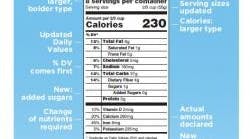The proposed label also would replace what the agency called "out-of-date serving sizes to better align with how much people really eat, and it would feature a fresh design to highlight key parts of the label such as calories and serving sizes."
"Our guiding principle here is very simple: that you as a parent and a consumer should be able to walk into your local grocery store, pick up an item off the shelf and be able to tell whether it’s good for your family," said First Lady Michelle Obama. "So this is a big deal, and it's going to make a big difference for families all across this country."
"For 20 years, consumers have come to rely on the iconic nutrition label to help them make healthier food choices," said FDA Commissioner Margaret Hamburg. "To remain relevant, the FDA’s newly proposed Nutrition Facts label incorporates the latest in nutrition science as more has been learned about the connection between what we eat and the development of serious chronic diseases impacting millions of Americans."
Some of the proposed changes to the label:
- Require information about the amount of "added sugars" in a food product. The 2010 Dietary Guidelines for Americans states that intake of added sugar is too high in the U.S. population and should be reduced. The FDA proposes to include “added sugars” on the label to help consumers know how much sugar has been added to the product.
- Update serving size requirements to reflect the amounts people currently eat. What and how much people eat and drink has changed since the serving sizes were first put in place in 1994. By law, serving sizes must be based on what people actually eat, not on what people “should” be eating.
- Present "dual column" labels to indicate both per serving and per package calorie and nutrition information for larger packages that could be consumed in one sitting or multiple sittings.
- Require the declaration of potassium and vitamin D, nutrients that some in the U.S. population are not getting enough of, which puts them at higher risk for chronic disease. Vitamin D is important for its role in bone health. Potassium is beneficial in lowering blood pressure. Vitamins A and C would no longer be required on the label, although manufacturers could declare them voluntarily.
- Revise the Daily Values for a variety of nutrients such as sodium, dietary fiber and vitamin D. Daily Values are used to calculate the Percent Daily Value on the label, which helps consumers understand the nutrition information in the context of a total daily diet.
- While continuing to require Total Fat, Saturated Fat, and Trans Fat on the label, Calories from Fat would be removed because research shows the type of fat is more important than the amount.
- Refresh the format to emphasize certain elements, such as calories, serving sizes and Percent Daily Value, which are important in addressing current public health problems such as obesity and heart disease.
The proposed updates reflect new dietary recommendations, consensus reports and national survey data, such as the 2010 Dietary Guidelines for Americans, nutrient intake recommendations from the Institute of Medicine, and intake data from the National Health and Nutrition Examination Survey (NHANES). The FDA also considered extensive input and comments from a wide range of stakeholders.
"By revamping the Nutrition Facts label, FDA wants to make it easier than ever for consumers to make better informed food choices that will support a healthy diet," said Michael Taylor, the FDA’s deputy commissioner for foods and veterinary medicine. "To help address obesity, one of the most important public health problems facing our country, the proposed label would drive attention to calories and serving sizes."
The Nutrition Facts label has been required on food packages for 20 years, helping consumers better understand the nutritional value of foods so they can make healthy choices for themselves and their families, the agency said. The label has not changed significantly since 2006 when information on trans fat had to be declared on the label, prompting manufacturers to reduce partially hydrogenated oils, the main source of trans fat, in many of their products.
The changes proposed today affect all packaged foods except certain meat, poultry and processed egg products, which are regulated by USDA's Food Safety and Inspection Service.
The FDA is also proposing to make corresponding updates to the Supplement Facts label on dietary supplements where applicable.
The agency is accepting public comment on the proposed changes for 90 days – which would mean a deadline of approximately May 26. The Federal Register notice is at www.federalregister.gov/regulations/0910-AF22/food-labeling-revision-of-the-nutrition-and-supplement-facts-labels.


